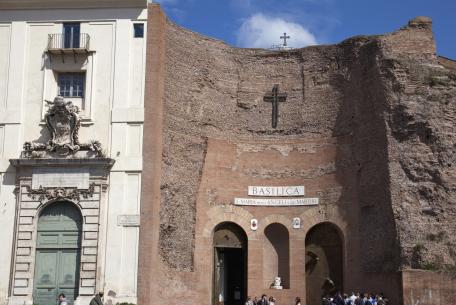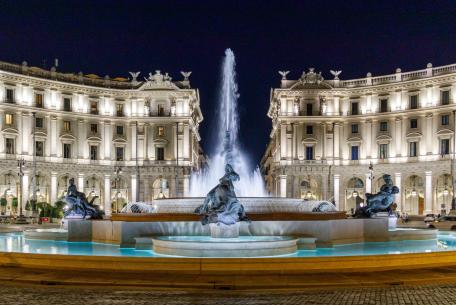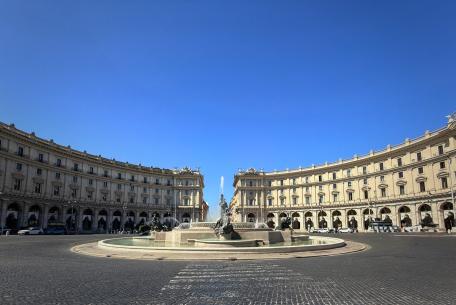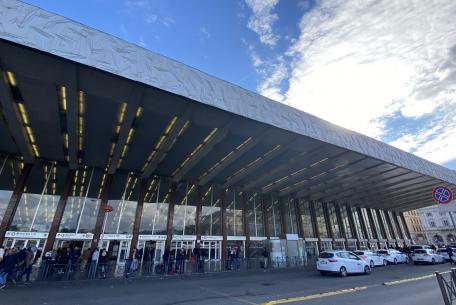You are here
Termini Station - Piazza della Repubblica - Via Nazionale


At the centre of the monumental Piazza della Repubblica is the most beautiful of the moder
[...]
Established in 1889 to house the antiquities of Rome, the National Roman Museum preserves the most important archaeological collection in the world.

Beautiful monumental expanse, Piazza della Repubblica was formerly called Piazza Esedra.

Located in the city center on Piazza dei Cinquecento, between Via Marsala and Via Giovanni Giolitti, Termini Station plays a role of primary importance in the city's regional, national, and interna
[...]In the area that includes the Roma Termini, Piazza della Repubblica, and Via Nazionale, one of the most eclectic in the city, antiquity and modernity come together to create a cultural and social melting pot full of fascinating influences and suggestions.
Roma Termini railway Station, which welcomes millions of travelers every year, is also a place where you can enjoy tempting delicacies or indulge in a pleasant shopping session before leaving. Piazza della Repubblica, on the other hand, captures you with the imposing architecture and the refined and austere style of the buildings designed by Gaetano Koch. Via Nazionale, one of the main shopping streets in Rome, welcomes you for a relaxing shopping tour among its elegant and sophisticated windows.
Located in the city center, Termini Station is the largest Italian railway station with a 225,000 square meters surface and approximately 850 trains a day serving 150 million travelers each year.
It was built in 1867 on a project by the architect Salvatore Bianchi among the fields and vineyards that populated the Rione Castro Pretorio. A few years later, however, it was already insufficient for the needs of a rapidly growing population. Thus began the necessary expansion interventions with the addition of temporary tracks and sheds. However, until 1905, the main building retained its original dimensions.
In 1925, the architect Angiolo Mazzoni built a new monumental forepart with an imposing porch and an atrium of 12 thousand square meters with the sole purpose of amazing the travelers who had walked it.
Mazzoni also took care of the interior decorations using precious national marbles that we can still admire today on the wall coverings in some station areas, such as the gigantic Mazzonian hood, a rare example of Futurist architecture.
In 1947, after the construction of the iconic canopy called "the Dinosaur," Termini Station assumed the shape we know today: a mix of styles between the 30s and 50s, integrated with modern interventions.
Inside, the Termini Forum is a 14,000 square meter service center with a wide selection of shops and products for all tastes. Acting as a pedestrian link between Via Marsala and Via Giolitti, the Central Gallery offers ideas for shopping, gourmet restaurants, and fast-food restaurants.
Initially called Piazza Esedra, Piazza della Repubblica is a beautiful monumental expanse that took its name from the great exedra of the Roman baths of Diocletian. Its perimeter traces the semicircular colonnade that frames it, a late 19th-century work by the great Turin architect Gaetano Koch. He was also the author of the imposing Umbertine palaces on the square.
The Basilica of Santa Maria degli Angeli e dei Martiri overlooks the square, a work by Michelangelo Buonarroti obtained from a wing of the Roman baths. On the splendid floor of the church, there is the Sundial or Clementine Line on which, with inlays of polychrome marbles, the zodiac signs of the summer and autumn constellations and the spring and winter constellations are represented.
Today, in the center of Piazza della Repubblica you can admire the beautiful Fountain of the Naiads, which constitutes the exhibition of the Aqua Marcia, adduced by Quinto Marcio Re from the upper Aniene Valley in 144 BC. The arrangement of the large square of the Esedra decided in 1885 established that the fountain of the Aqua Marcia should rise in the center of Piazza della Repubblica as a background of Via Nazionale.
The fountain, by Mario Rutelli, presents four colossal bronze groups. They depict four nymphs, each lying on an aquatic animal symbolizing water in its various forms: a sea horse for the Nymph of the Oceans, a water snake for the Nymph of the Rivers, a swan for the Nymph of the Lakes, a lizard for the Nymph of the underground Rivers.
The Baths of Diocletian also overlook Piazza della Repubblica, which, together with Palazzo Massimo alle Terme, Palazzo Altemps, and Crypta Balbi, are part of the National Roman Museum which houses the world’s most important archaeological collection.
The elegant Via Nazionale, one of the essential stops in Rome's shopping, branches off from Piazza della Repubblica.
Between a refined clothing shop and a Bistrot where you can savour delicacies even for the most demanding palates stands the magnificent Palazzo Esposizioni Roma, a majestic white building by the great architect Pio Piacentini, today a place of culture and charm.
On the right of Via Nazionale is Rome's Opera House, a fascinating temple for opera and ballet created by the contractor Domenico Costanzi in the area formerly occupied by the villa of Eliogabalo.
If you head towards Piazza Venezia and keep left, you can visit the Quirinal Palace, the seat of the Presidency of the Republic. With an area of 110,500 square meters, it is the world's sixth-largest building, 20 times larger than the White House, and a place of tourist attraction for the beauty of its architecture. The Palace, endowed with a unique heritage of art, history, and culture, is the work of Domenico Fontana, Carlo Maderno, and Gian Lorenzo Bernini, who, there, created the suggestive Loggia delle Benedizioni.











































